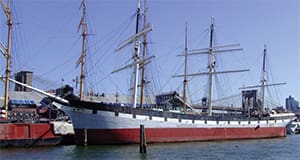In May 2015, Wavertree, the last remaining and largest of the wrought-iron, full-rigged ships, was towed from her home at the South Street Seaport Museum across the bay to Staten Island. Carefully placed in dry dock, Wavertree was brought to Caddell Dry Dock & Repair Co., where this great relic of the once-ubiquitous sailing ships that plied their trade all over the world will receive $10 million worth of loving restoration.
Wavertree, built in Southampton by Oswald, Mordaunt & Co., was launched as the 2,170-gt Southgate in 1885. The new ship was a twin-decker measuring 279 feet, with a 40-foot beam and a 24-foot draft.
The thinking was that square-rigged ships would be able to get around Cape Horn to Peru or Chile for the valuable nitrate trade. There was also a ready market for hauling rice and teak from Burma, and case oil from New York. These ships required no auxiliary power and had immense cargo capacity. Crews were disposable and operating costs were low. Yet, as Alan Villiers has written, “The big full-rigged ship could be brutish to tack, for the main and mizzen yards must be slung together at the right moment, or else. … These ships were apt to be hard-mouthed, sluggish, big bullocks to swing across the wind, mankillers for their small crews; and their long, open decks were awash in the terrible seas as they rolled down there off the Horn.”
Wavertree slogged on, understaffed and overworked, until 1910 when on her second approach in a few months to round Cape Horn, the main mast snapped and the ship, in danger of foundering, struggled back to the Falkland Islands. Unsalvageable, she was sold and towed to Punta Arenas to serve as a sand barge.
This ship was lucky, however. In the mid-1960s, Karl Kortum, founder of the San Francisco Maritime Museum, discovered the hulk and, with the help of Peter Stanford and Jakob Isbrandtsen of the newly formed South Street Seaport Museum, arranged to have the hull towed to Pier 16 on the East River. Then began years of volunteer restoration efforts that finally culminated in a $10 million donation that took the ship to Staten Island.
The ship will never sail again but will be a centerpiece at the South Street Seaport Maritime Museum.
Let’s join the skipper trying to round Cape Horn on Dec. 1, 1910 (use the 2016 Nautical Almanac). There are no sun sights for two days and gale-force winds from the west. Finally, the skipper gets a lower limb observation of the sun. His height of eye is 25 feet. The DR is 58° 16’ S by 65° 27’ W. The time of his observation is 14:30:15 GMT, and the HS is 50° 18’. What is the HO? Plot the line of position. What is the estimated position?
Note: This is an interesting observation because one can clearly see from the position of the sun line relative to the DR that the actual position of Wavertree was behind the dead reckoning position. This was not due to captain’s error but instead to the strong headwinds and current coming from the west that made headway for the ship difficult.
A. What is the Ho?
B. What is the intercept?
C. What is the EP?
Answers:
A. Ho is 50° 28.5’
B. Intercept is 49.5 nm toward
C. The EP is 57° 22’ S by 64° 44’ W

